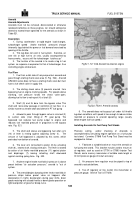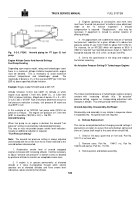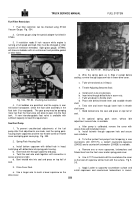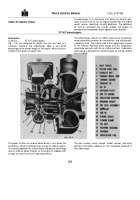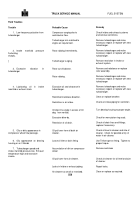TM-5-3805-254-14-P-2 - Page 554 of 894
TRUCK SERVICE MANUAL
FUEL SYSTEM
when throttle is opened after down grade closed throttle
motoring and prevents the engine from stalling when it
decelerates to idle.
a.
Excessive throttle leakage will cause engine to
decelerate too slowly.
b.
Insufficient throttle leakage will cause engine
response hesitation after closed throttle motoring and stalling
after decelerating to idle.
Note:
If throttle leakage is adjusted correctly on fuel pump
test stand, adjustment after fuel pump installation on engine is
not required.
3.
If throttle leakage adjustment on engine is required, it
should be performed in the following manner.
4.
Engine must be operated long enough to purge all air
from fuel system and at operating temperature.
CAUTION
Never check engine deceleration or adjust throttle leakage
on a cold engine.
Engine will decelerate faster when cold
due to greater friction drag.
5.
Vehicle throttle linkage must be adjusted so pump
throttle just contacts the front throttle stop screw when throttle
is closed.
6.
A fuel manifold pressure gauge must not be in use.
7.
A stop watch or other suitable timer and tachometer
must be used to perform the following check.
8.
With transmission in neutral or clutch disengaged,
open throttle fully and let engine run at hi-idle (maximum no
load speed).
a.
Release or move throttle to closed position quickly
and start stop watch simultaneously.
b.
Stop the stop watch when engine reaches 1000 rpm
and note deceleration time.
Repeat several times.
c.
If engine begins to stall (idle governor does not catch
engine) after decelerating from hi-idle, throttle leakage must
be increased.
(1)
Note position of throttle leakage adjusting screw
(front throttle stop screw).
(2)
Turn screw in while checking engine deceleration as
described previously until deceleration time is increased 1 to 2
seconds.
Lock screw in this position and recheck idle speed.
Readjust as necessary.
9.
If engine decelerates too slowly, it may be necessary
to decrease
throttle
leakage.
Before
decreasing
throttle
leakage, be sure it is required by first checking deceleration
time when shutdown valve is closed (engine is shutdown)
while running at hi-idle.
If deceleration is no faster by this
method, throttle leakage is not the problem.
If deceleration is
significantly faster by this method, throttle leakage should be
reduced.
a.
Note position of throttle leakage adjusting screw.
b.
Back screw out while checking engine deceleration
as described previously until engine tends to stall after
decelerating from hi-idle.
Turn screw in until deceleration time
is increased 1 to 2 seconds.
Lock screw in position and check
idle speed.
Adjust idle speed as required.
Adjusting Dual Power Torque Limiting Valve
This valve must be adjusted when engine is on a
dynamometer.
1.
When fuel pump is calibrated, the valve solenoid is
energized or valve adjusting sleeve is bottomed, allowing full
fuel flow.
2.
Normal engine testing may be completed with valve
locked open in this manner.
3.
To adjust valve, remove aneroid fuel lines and plug
holes, remove valve solenoid wires and remove sealing plug
from front of valve body.
4.
With solenoid De-energized, start engine and
increase speed to high idle.
5.
Apply load on dyno until 1200 rpm is reached.
Adjust
valve sleeve until your application specification is obtained.
6.
Install valve sealing plug and record value obtained
7.
Connect solenoid wires, remove aneroid plugs and
replumb aneroid.
8.
Recheck engine power at rated speed.
Engine Power
1.
Engine power cannot be gauged accurately in any
way except on an engine dynamometer.
Any other method of
gauging engine power requires the use of assumptions, feel,
opinions regarding accessory drive train power losses and
load measuring equipment accuracy.
2.
Fuel pump adjustments should not be made based
on estimated power arrived at by this means unless full
performance data (fuel manifold pressure, fuel rate, speed
settings,
smoke,
coolant
temperature,
combustion
smoothness, exhaust restriction, fuel quality, air intake
restriction, crankcase oil level and engine power derate
factors) also indicates the adjustments are justified.
Under no
circumstances should these specifications be exceeded.
Note:
As in all fuel systems and engine performance checks,
accurate instruments must be used.
3.
Engine rated power (maximum power at engine rated
speed) should be checked in the same way as "checking and
adjusting engine fuel manifold pressure" and "checking and
adjusting engine fuel rate" as previously described.
4.
Check governor cutoff setting to assure this is not
influencing rated power
549
Back to Top


